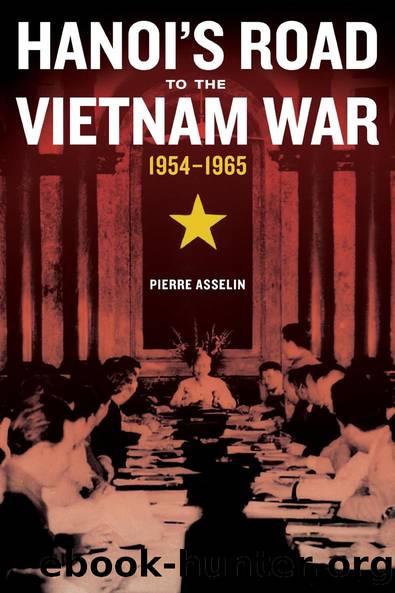Hanoi's Road to the Vietnam War, 1954-1965 (From Indochina to Vietnam: Revolution and War in a Global Perspective) by Pierre Asselin

Author:Pierre Asselin [Asselin, Pierre]
Language: eng
Format: epub
ISBN: 9780520276123
Publisher: University of California Press
Published: 2013-08-02T06:00:00+00:00
THE COUP AGAINST DIEM
The climatic episode that would push Hanoi into a definitively militant strategy in the South came in the fall, when the political landscape there changed suddenly and radically. On 2 November 1963, Diem and his brother Nhu were killed in a coup by ARVN officers. General Duong Van Minh thereafter became head of the Saigon government. Publicly, DRVN leaders dismissed Diemâs overthrow as a mere change of personnel, further proof of the bankruptcy of Washingtonâs policies in the South. Privately, however, they were alarmed. Specifically, they feared that the new leadership might rally popular support for its policies, setting back the revolution in the South. âSigns of this fear are the constant warnings in the North Vietnamese press and on the South Vietnamese Liberation Radio to the people of South Vietnam not to be duped by the new Governmentâs talk of âdemocracy and freedom,ââ western observers noted.116
DRVN leaders believed then and Vietnamese scholars believe now that Washington engineered the coup.117 In Hoc tap, Ha Van Lau of the Foreign Ministry immediately postulated that the Kennedy administration, bent on precipitating a wider war, had sanctioned the coup because Diem had failed to âsatisfyâ Washingtonâs requirements of âsavingâ the South and âcrushing the Viet Cong rebellion.â118 By most Vietnamese accounts, the Kennedy administration engineered the overthrow to gain greater freedom of action in the South.119 Diem had behaved too independently, according to these sources, and Washington replaced him with a more pliable leader.120 Luu Doan Huynh, a late Vietnamese diplomat, noted that as early as 1962 Hanoi began noticing âincreasing contradictionsâ between Diemâs regime and Washington and felt some trepidation, not knowing what this might presage.121 For many in Hanoi, the coup confirmed what they suspected all along: that the United States had from the beginning intended to assume the colonial mantle from the French in Indochina.
To many in the VWP, the coup was tantamount to revolution, marking as it did the transition from a bourgeois reactionary to a military counterrevolutionary regime in Saigon.122 Reprehensible as the former had been, it was preferable to the latter because it had included civilian and nationalist elements. Leaders of the new regime were nothing but lackeys handpicked by Washington for their eagerness to benefit from Americaâs neocolonial project. In the words of historian Le Cuong, the Kennedy administration had replaced a nepotistic regime with a âmost submissiveâ one.123 The French historian Philippe Franchini has drawn a parallel conclusion. âThe arrival to power of a junta suggested the reinforcement of [Saigonâs] ties to the United States,â Franchini has written, the âexpected effectâ of which for Hanoi was âan increased American engagement that threatened to imperil the southern liberation movement.â124
In the more direct language of a former Hanoi official, the coup âincreased the danger of U.S. direct military interventionâ in South Vietnam.125 The new leadership in Saigon existed, according to another source, for the express purpose of creating political conditions that would enable the Americans to step up the hostilities in the South to their fullest extent.
Download
This site does not store any files on its server. We only index and link to content provided by other sites. Please contact the content providers to delete copyright contents if any and email us, we'll remove relevant links or contents immediately.
The Light of Days by Judy Batalion(829)
Stalin's War: A New History of World War II by Sean McMeekin(689)
Walk in My Combat Boots by James Patterson(615)
The Pacific War 1941-1943 by James Holland(612)
Victory's Price (Star Wars) by Alexander Freed(581)
The Vietnam War: An Intimate History by Geoffrey C. Ward & Ken Burns(570)
First Platoon: A Story of Modern War in the Age of Identity Dominance by Annie Jacobsen(566)
The American War in Afghanistan by Carter Malkasian(559)
Cold War (Alexander King Book 2) by Bradley Wright(558)
Operation Pedestal by Max Hastings(544)
Blood and Ruins: The Great Imperial War, 1931-1945 by Richard Overy(531)
The Madman Theory by Jim Sciutto(523)
Concepts of Space by Jammer Max;(520)
Extreme Fitness by Chris McNab(516)
World War II Infantry Fire Support Tactics by Gordon L. Rottman(504)
Flying Tiger by Samson Jack(502)
Pathfinders by AL-KHALILI JIM(498)
Panzerkrieg by Mike Syron(490)
Hitler’s Pre-Emptive War: The Battle for Norway, 1940 by Henrik O. Lunde(486)
